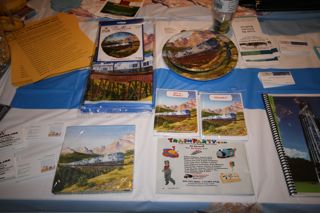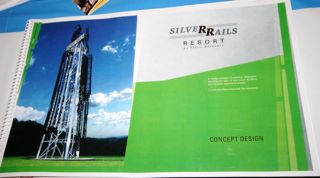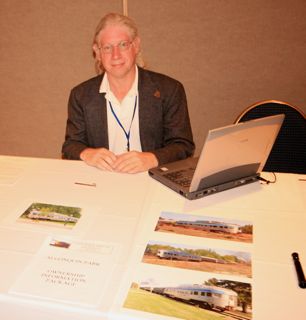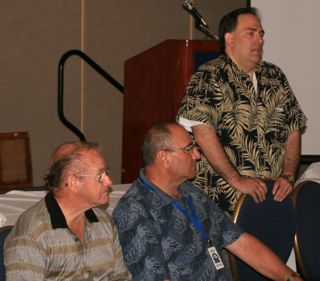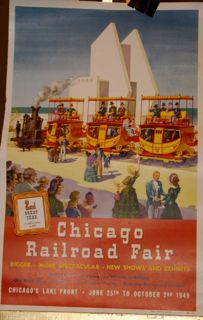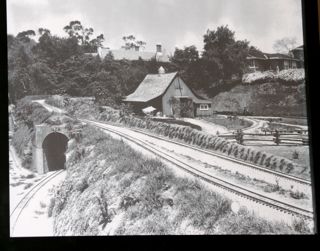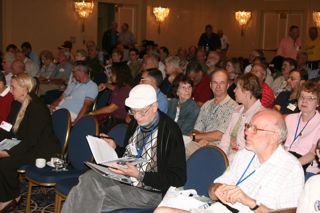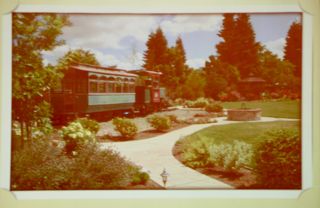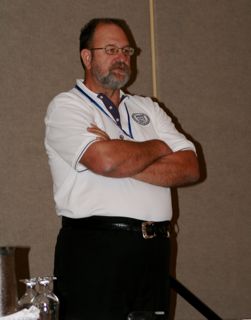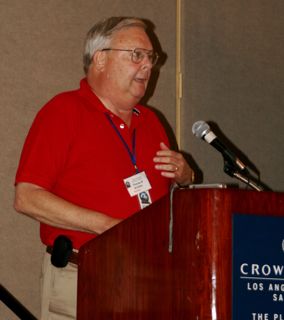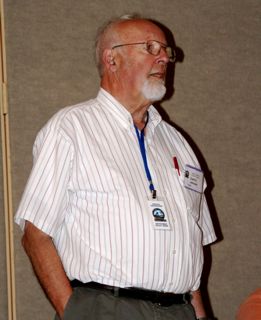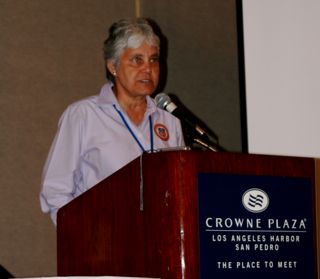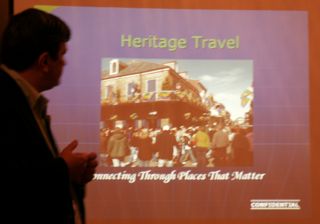San Pedro, California,
September 20 - 24, 2008.
10:30 am "Walt Disney: I Have
Always Loved Trains! Michael Campbell, Pres. ,
Carolwood Pacific Hisotircal Society.
Scott's orginization's mission is to fight to save the country’s
irreplaceable architectural, cultural and natural heritage. They
restore historic downtowns, barns, hotels, etc.
His orginization wants to have a strong Internet presence since 70% of
all travel has been researched and booked online, only 20% offline.
Sites on the 2007 list of America’s 11 Most Endangered Historic Places
are:
Brooklyn’s Industrial Waterfront, N.Y. -- Once a booming 19th-century
industrial waterfront supported by generations of immigrants,
Brooklyn’s heritage is at risk as historic dockyards and factories are
being demolished by developers anxious to cash in on the area’s newly
hip status.
El Camino Real de Tierra Adentro National Historic Trail, N. Mex. --
The earliest Euro-American trade route in the United States, the El
Camino Real de Tierra Adentro, known for its austere physical beauty,
rural solitude and remote isolation, is threatened by a $225 million
commercial Spaceport, a venture planned adjacent to one of the most
pristine and sacred segments of the Trail.
H.H. Richardson House, Brookline, Mass. -- The last home and studio of
famed 19th-century American architect Henry Hobson (H.H.) Richardson –
the creator of Boston’s much loved landmark Trinity Church – is vacant
and vulnerable to demolition unless a preservation-minded buyer comes
forth to rescue the legacy of the man who created the “Richardsonian
Romanesque” style.
Hialeah Park Race Course, Hialeah, Fl. – The drop dead gorgeous
1925 racetrack known for its stunning Mediterranean architecture and
pink flamingos, Hialeah Park – frequented by celebrities such as
Winston Churchill, Harry Truman and Seabiscuit – is threatened with a
planned 3,760-unit condo and apartment complex with nearly
one-million-square feet of retail and 200,000-square-feet of office
space, which would destroy much of the storied park.
Historic Places in Transmission line Corridors, Va., W. Va., Md., Pa.,
N.Y., N.J. Del. – Seven states – many of them in the Mid-
Atlantic region -- are waging battles to protect everything that’s
irreplaceable about their communities as massive 150-foot tall, 75-foot
wide high voltage transmission lines are planned that will blight
historic landscapes and usurp private property rights. Proposed
lines would cut through private land, publicly held open space,
neighborhoods, historic sites, historic districts and magnificent
viewsheds.
Historic Structures in Mark Twain National Forest, Mo. -- Established
by President Franklin D. Roosevelt in 1939, the 1.5-million-acre Mark
Twain National Forest is known for rocky bluffs, pastoral views and
historical sites which speak to the region’s rich heritage – from
intact 19th-century frontier farmsteads to New Deal-era fire lookouts
and ranger stations. Today, due to U.S. Forest Service budget
limitations, many properties are vacant, unsecured, deteriorating and
threatened with demolition.
Historic Route 66 Motels, Ill. To Calif. -- Affectionately called “The
Mother Road,” Route 66 is known for quirky roadside attractions and
unique mom-and-pop motels, constructed between the late 1920 and late
1950s and often clad in neon. In recent years, Route 66 motels in
hot real-estate markets have been torn down at record rates, while in
cold real-estate markets, motels languish and are being reclaimed by
the forces of nature.
Minidoka Internment National Monument, Jerome County, Idaho -- From
1942 to 1945, thousands of Nisei (Japanese American citizens and
immigrants of Japanese ancestry) were sent to south central Idaho to
live in camps under armed guard at the Minidoka Relocation
Center. Today a National Monument, the site, which once contained
more than 600 buildings, offers scant visitor services or interpretive
information, and is threatened by insensitive local land-use planning,
including the proposed siting of a massive animal feed operation just
over a mile away.
Philip Simmons’ Workshop and Home, Charleston, S.C. -- Beloved master
blacksmith Philip Simmons has spent the better part of 80 years
adorning his hometown with intricate ornamental ironwork – gates,
fences, stair rails and window grills -- but with no plans to preserve
his home and studio, the legacy of this 95-year-old artisan is in
jeopardy.
Pinon Canyon, Colo. -- In Southeastern Colorado, under uninterrupted
blue skies, the Pinon Canyon area includes scenic buttes, river
valleys, family ranches and historic and archeological sites that span
11,500 years. The area is threatened by the U.S. Army’s plans to
expand its Pinon Canyon Maneuver Site by as much as 408,000 acres, a
move that could lead to forced condemnation of private lands and damage
or destroy historic Santa Fe Trail monuments, ranches, and historic and
prehistoric archeological sites.
Stewart’s Point Rancheria, Sonoma County, Calif. -- The Kashia Pomo
Native American tribe has inhabited this Northern California land for
thousands of years. But because a federal program to protect tribal
historic resources is seriously under-funded, the Kashia, like many
tribes, is losing its sacred and historic sites to looters, vandals and
the elements.
2007 marks the 20th listing of America’s 11 Most Endangered Historic
Places
Since 1988, the National Trust for Historic Preservation has used its
list of America’s 11 Most Endangered Historic Places as a powerful
alarm to raise awareness of the serious threats facing the nation’s
greatest treasures. This year, the Trust celebrates the list as
one of the most effective tools in the fight to save the country’s
irreplaceable architectural, cultural and natural heritage. The
list, which has identified 189 sites through 2007, has been so
successful in galvanizing preservation efforts across the country and
rallying resources to save one-of-a-kind landmarks that in just two
decades, an astounding 52 percent of the sites have been saved and
rehabilitated. While the fight is not over for many of these
historic places, only 6 sites have been lost since the Trust launched
the 11 Most Endangered program. For more information, visit
www.nationaltrust.org/11most/20th.
America’s 11 Most Endangered Historic Places has identified 189
threatened one-of-a-kind historic treasures since 1988. While a listing
does not ensure the protection of a site or guarantee funding, the
designation has been a powerful tool for raising awareness and rallying
resources to save endangered sites from every region of the country.
Whether these sites are urban districts or rural landscapes, Native
American landmarks or 20th-century sports arenas, entire communities or
single buildings, the list spotlights historic places across America
that are threatened by neglect, insufficient funds, inappropriate
development or insensitive public policy. For more information, visit
www.nationaltrust.org/11most.
--From:
http://press.nationaltrust.org/content/view/136/162/



